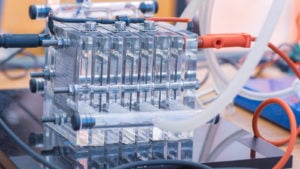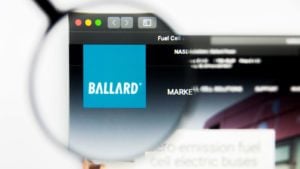Hydrogen technology has been around for over 20 years. But it’s always been too complicated, too expensive, too “something” to become a viable source of renewable energy. And that’s made it hard for all but the truest of true believers to get excited about investing in hydrogen stocks.
That’s because while hydrogen is a source of clean power, it comes with practical problems. One of the primary problems is that hydrogen is expensive to produce because it does not occur naturally as a fuel. This means that consumer prices make hydrogen products an obstacle. For example, a fuel cell engine can cost up to 10 times as much as a conventional engine. And, like other renewable energy sources, there is no developed hydrogen infrastructure, which further holds back its adoption.
But that may all be changing. Prior to the global lockdown that crashed demand for oil, many companies were in the process of developing solutions that would give hydrogen a chance to become more than a someday idea.
And according to Dr. Fatih Birol, the executive director of the International Energy Agency, hydrogen may be ready to be a viable renewable energy source:
“Hydrogen is today enjoying unprecedented momentum. The world should not miss this unique chance to make hydrogen an important part of our clean and secure energy future.”
The list of publicly traded companies that are involved with hydrogen and fuel cell technology is surprisingly long. And the good news for investors is that they still offer a long runway for growth. Of course, none of these companies are profitable yet, which means they carry a sizable risk. But if you’re willing to dabble in the sector here are three of the best hydrogen stocks to consider:
Hydrogen Stocks: FuelCell Energy (FCEL)

On June 12, FuelCell posted revenue that was 21% higher than analysts’ expectations. But the company delivered earnings per share (EPS) that essentially met expectations with a loss of 7 cents per share. Not surprisingly, FCEL stock jumped over 20% on the report. However, it has since given back nearly all its gains.
An encouraging sign for the company was continued strength in its Advanced Technologies business which posted a profit of $200,000 in the quarter. That would seem to indicate that the company is still reaping the benefits from its partnership with Exxon Mobil (NYSE:XOM).
That’s the good news. The potentially bad news is that, while FuelCell is not directly impacted by oil prices, Exxon is. And there is some concern that Exxon shareholders may not be so accepting of its FuelCell investment when the company may struggle to pay its dividend.
But that’s the risk of hydrogen stocks. Overall, the last two months have been very good for FuelCell. At one point, shares of FCEL stock had climbed over 200%. But even with a sharp pullback on June 11, a move that followed the trend of the broader market, FuelCell shares are still holding an impressive gain.
Plug Power (PLUG)

If you had to pick a leader in the clubhouse of hydrogen stocks, you’d have to give PLUG stock strong consideration. And the reason is simple. It has contracts with Amazon (NASDAQ:AMZN) and Walmart (NYSE:WMT), which use the company’s fuel cell technology to power forklifts. That gives Plug Power a compelling use case, particularly as investors may finally be ready to deal with a world with less demand for oil.
But, Plug Power has what investors find to be an irritating habit. It hasn’t turned a profit in its 23 years of trading. This is because, although Plug Power has impressively increased its revenue from $14 million to over $250 million in just one year, it continues to burn through cash.
But according to S&P Global Market Intelligence, that may be changing. The firm projects that Plug Power will be profitable in 2023. That coincides with an encouraging outlook from Barclays Capital. The British firm initiated coverage on PLUG stock with a $7 price target.
Ballard Power Systems (BLDP)

BLDP stock is up over 90% in 2020. According to the company’s website, Ballard has “shipped over 670 MW of PEM fuel cell products.” But that hasn’t yet translated to the company’s bottom line.
In its first-quarter earnings report, Ballard missed on both the top and bottom lines. In terms of revenue, the record $24 million the company generated was over 40% better on a year-over-year basis.
Additional highlights included a 22% gross margin and $181.6 million in cash reserves. The company also predicted that hydrogen refueling infrastructure may benefit from stimulus packages that are being put in play in Europe, China and the United States.
But the bottom line dropped from a loss of 4 cents per share to a loss of 6 cents per share.
This just illustrates the problem that Ballard continues to have. It needs to be able to make substantial progress in seeding its technology in markets such as buses, trains, and trucks. Until it does, the company will struggle to be profitable.
Chris Markoch is a freelance financial copywriter who has been covering the market for over five years. He has been writing for InvestorPlace since 2019. As of this writing, Chris Markoch did not hold a position in any of the aforementioned securities.
